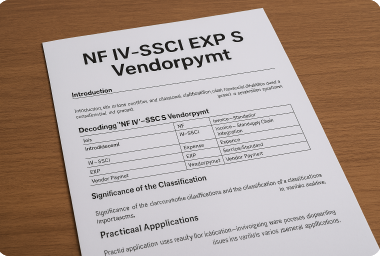Introduction
In today’s fast-paced financial environments, accuracy, classification, and transparency are essential for smooth operations, especially when it comes to handling vendor payments. One such term that appears frequently in financial systems, particularly in government and large organizations, is nf iv-ssci exp s vendorpymt.
While it might look like a cryptic string of characters, this term represents a standardized classification that plays a vital role in processing vendor-related expenditures. Understanding its meaning can help accountants, auditors, financial analysts, and business owners maintain compliance, improve documentation, and optimize their financial workflows.
Decoding “NF IV-SSCI EXP S Vendorpymt”
Let’s break down the term nf iv-ssci exp s vendorpymt to understand what each part stands for and why it matters.
| Component | Meaning | Purpose |
|---|---|---|
| NF | Non-Federal or Net Funds | Indicates a transaction that does not involve federal funds or is classified as net funds within internal financial systems. |
| IV-SSCI | Invoice – Standard Supply Chain Integration | Refers to standardized invoice processing and categorization under supply chain systems. |
| EXP | Expense | Confirms that the transaction is an expenditure. |
| S | Service/Standard | Suggests a standard or service-related transaction under routine financial processes. |
| Vendorpymt | Vendor Payment | Signifies payment issued to a vendor for goods or services rendered. |
When put together, nf iv-ssci exp s vendorpymt refers to a vendor payment made as an expense under standard procedures, often part of a non-federal or internal budget, tracked through an integrated supply chain system.
Why This Classification Matters
Classifying financial transactions correctly is not just a bureaucratic step; it has real-world implications. For instance, when you classify a payment using nf iv-ssci exp s vendorpymt, it immediately becomes traceable, auditable, and compliant with internal or governmental standards. This means:
- Improved Financial Reporting:
Accurate categorization enables precise reporting for stakeholders, auditors, and regulators. - Streamlined Audits:
Well-labeled transactions simplify the audit trail, saving time and reducing risk. - Regulatory Compliance:
Using classifications like nf iv-ssci exp s vendorpymt helps businesses adhere to procurement laws and financial regulations. - Operational Transparency:
Clear labeling of transactions increases accountability across departments.
Real-World Applications
The usage of nf iv-ssci exp s vendorpymt is common in multiple sectors. Here’s how it’s applied across different financial environments:
1. Government Finance
Government departments use this classification to distinguish vendor payments made with internal funds, ensuring alignment with federal spending rules and internal accounting structures.
2. Corporate Accounting
Private organizations utilize this classification within enterprise resource planning (ERP) systems like SAP or Oracle to manage vendor expenses and maintain clean financial records.
3. Educational Institutions
Universities and colleges often deal with government grants and internal funds. Using the nf iv-ssci exp s vendorpymt tag helps them separate federally funded transactions from institutional ones.
Advantages of Using “NF IV-SSCI EXP S Vendorpymt”
Using this classification comes with a host of benefits that extend beyond compliance:
- Efficient Financial Oversight
Managers can easily identify vendor-related expenses and track them by type and funding source. - Better Budget Control
Organizations can allocate budgets more accurately by analyzing expense categories labeled under nf iv-ssci exp s vendorpymt. - Automated Workflows
Many ERP systems recognize this tag and automate approvals, documentation, and payment releases. - Faster Reconciliation
Monthly and quarterly reconciliations become quicker when transactions are properly tagged and classified.
Challenges in Implementation
Despite its benefits, implementing a classification system like nf iv-ssci exp s vendorpymt can present some challenges:
- Learning Curve
Finance teams may require training to understand and apply the classification correctly. - Data Entry Errors
Manual entry of complex codes can lead to misclassification, causing confusion in reporting. - System Integration
Older accounting systems might not support such standardized tags without customization or upgrades. - Audit Complexity (When Used Incorrectly)
Mislabeling vendor payments can create audit risks and compliance issues.
Best Practices for Smooth Implementation
To ensure successful usage of nf iv-ssci exp s vendorpymt, follow these proven practices:
1. Train Your Finance Team
Make sure everyone handling payments understands what this classification means and when to use it.
2. Use Modern Financial Tools
Choose accounting or ERP systems that support tagging and allow custom classification fields.
3. Set Up Validation Rules
Automated checks can prevent errors by verifying that only appropriate expenses are tagged as nf iv-ssci exp s vendorpymt.
4. Maintain a Classification Manual
Create an internal guide that explains common codes and their proper usage, updated regularly with real-life examples.
Technological Evolution of Vendor Payments
Modern finance is evolving, and so are the ways we classify vendor payments. With the rise of AI, automation, and integrated cloud systems, the use of standardized codes like nf iv-ssci exp s vendorpymt is being embedded directly into workflows.
Key Innovations Include:
- AI-Based Invoice Scanning:
Recognizes the classification from scanned documents and assigns it automatically. - Integrated Vendor Portals:
Vendors submit invoices that are pre-tagged with the correct classification. - Real-Time Dashboards:
Financial teams can monitor all vendor payments in real time, filtered by classification.
Conclusion
Understanding and properly using the term nf iv-ssci exp s vendorpymt is crucial for any organization that deals with vendor payments. It’s more than just a technical label — it’s a tool for maintaining financial clarity, improving efficiency, and ensuring compliance.
Whether you’re in government finance, corporate accounting, or higher education, integrating this classification into your workflow will bring long-term benefits and cleaner audit trails. As systems become more advanced, mastering this terminology will put your financial operations one step ahead.
Frequently Asked Questions (FAQs)
Q1. What does “nf iv-ssci exp s vendorpymt” mean in simple terms?
It refers to a vendor payment made as an expense, under a standard financial classification involving non-federal or internal funds.
Q2. Where is this classification commonly used?
In government departments, universities, and large businesses that follow strict accounting structures.
Q3. Is it mandatory to use this classification?
While not always mandatory, using standardized terms like nf iv-ssci exp s vendorpymt greatly helps in organizing and tracking expenses.
Q4. Can ERP software recognize this term?
Yes, most modern ERP systems can be configured to classify and track such codes automatically.
Q5. How can I prevent mistakes when using this classification?
Invest in staff training, use automation tools, and create clear internal guidelines.
Related Articles
Fixing the “Backboard Failed to Send Ping iOS 14.6” Error: A Complete Guide for iPhone Users
Throne of Seal Insert E108 Pan Xiuyu: Complete Breakdown and Character Insight
Johan Espinosa Software Libre: A Comprehensive Guide to His Vision and Contributions

